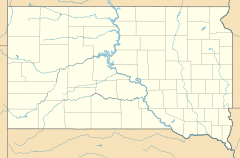Prairie City, South Dakota facts for kids
Quick facts for kids
Prairie City
|
|
|---|---|
| Country | United States |
| State | South Dakota |
| County | Perkins |
| Township | Strool |
| Area | |
| • Total | 1.42 sq mi (3.68 km2) |
| • Land | 1.41 sq mi (3.65 km2) |
| • Water | 0.05 sq mi (0.13 km2) |
| Elevation | 2,861 ft (872 m) |
| Population
(2020)
|
|
| • Total | 25 |
| • Density | 17.6/sq mi (6.79/km2) |
| Time zone | UTC-6 (Central (CST)) |
| • Summer (DST) | UTC-5 (CDT) |
| ZIP codes |
57649
|
| Area code(s) | 605 |
| GNIS feature ID | 2584566 |
Prairie City is a small, unincorporated community located in Perkins County, South Dakota, United States. It's also known as a census-designated place, which means it's an area identified by the government for gathering census information, even though it's not an officially organized town. Prairie City was started in 1946 by people who moved from a nearby community called Strool. According to the 2020 census, 25 people live there.
Contents
History of Prairie City
Prairie City was founded in 1946 by Dutch Stalder. Many of its first residents came from a nearby place called Strool.
Why People Moved from Strool
The town of Strool was completely owned by its founder, Ben Strool. He rented out land to people and businesses but never sold any of it. This meant that people living and working in Strool didn't own their property. They were worried about building permanent structures, like homes with basements, because they could lose their investment if they had to move.
Also, a railroad and a main highway were planned to go through Strool at first. But later, they were built several miles away. This made Strool hard to get to, which was not good for businesses or residents.
Starting a New Community
By 1946, some Strool residents decided to move about two miles north to create Prairie City. This new location was closer to the highway. More importantly, settlers could actually buy land in Prairie City, meaning they would own their homes and businesses.
Several things sped up the move to Prairie City:
- Electricity Arrives: In 1952, electricity became available in the area thanks to the Rural Electrification Act. People didn't want to install electricity in buildings they didn't own in Strool.
- Ben Strool's Death: Ben Strool died in 1949. After his death, there was a disagreement over who owned Strool. This made people even more eager to leave.
By 1955, most of the move to Prairie City was finished. So many people moved there so quickly that Prairie City was briefly called "the fastest-growing town" in South Dakota!
Post Office and Census
Prairie City's post office opened in 1955. It was first officially counted as a census-designated place in the 2010 census. In 2009, the post office closed down, but Prairie City still uses its 57649 ZIP code. Now, postal services for Prairie City are handled by the town of Bison.
Population Information
| Historical population | |||
|---|---|---|---|
| Census | Pop. | %± | |
| 2010 | 23 | — | |
| 2020 | 25 | 8.7% | |
| U.S. Decennial Census | |||
2020 Population Count
| Race | Number | Percentage |
|---|---|---|
| White | 20 | 80.0% |
| Native American | 2 | 8.0% |
| Asian | 1 | 4.0% |
| Other/Mixed | 2 | 8.0% |
| Hispanic or Latino | 2 | 8.0% |
In 2020, there were 25 people living in Prairie City. The population density was about 17.7 people per square mile. This means that, on average, there were about 18 people living in every square mile of the area. There were also 18 housing units, or places where people live.
2010 Population Count
In 2010, Prairie City had 23 people living there. The population density was about 16.2 people per square mile. All of the residents were white.
There were 9 households in total. A household is a group of people living together in one home. Out of these, 3 were married couples, and 1 had a female head of household without a husband present. Five households were made up of individuals living alone. Two of these individuals were 65 years old or older.
The population included 9 people (39.1%) under 18 years old, and 2 people (8.7%) who were 65 or older. The average age of residents was 43.5 years.
Notable People from Prairie City
Some well-known people have connections to Prairie City:
- J. Sam Marty (born 1947), a politician who works in government.
- Betty Olson (born 1946), also a politician.
See also
 In Spanish: Prairie City (Dakota del Sur) para niños
In Spanish: Prairie City (Dakota del Sur) para niños



